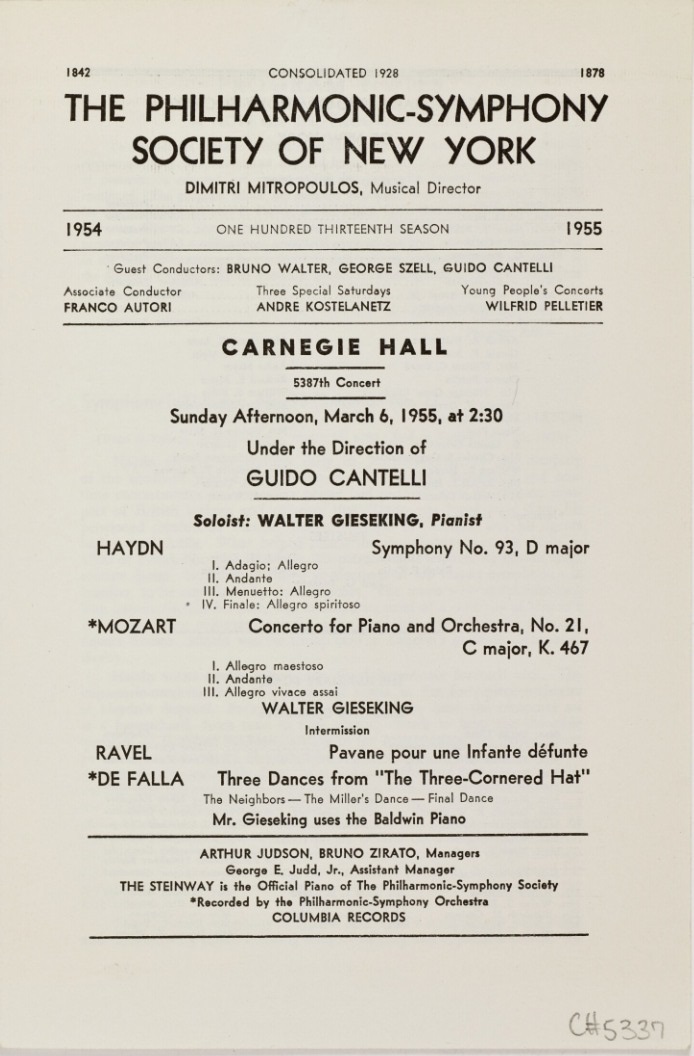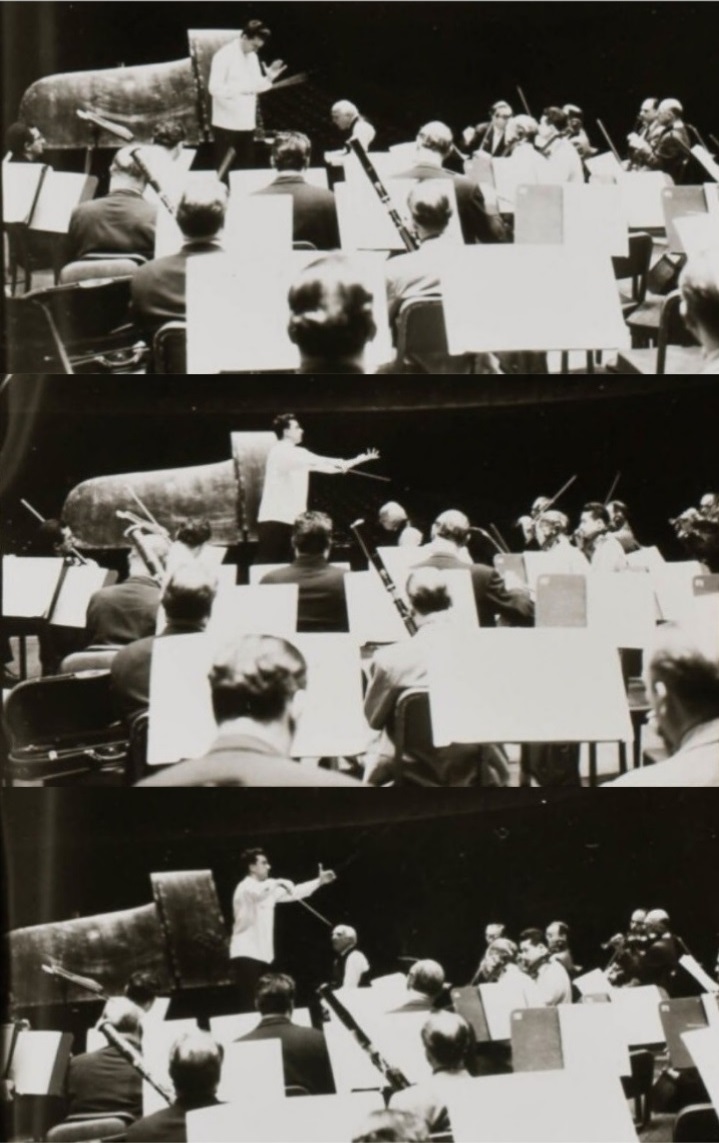Étiquette : Walter Gieseking

Cadences/Cadenzas: Ferrucio Busoni
Walter Gieseking, Baldwin piano – Guido Cantelli New York Philharmonic (NYPO)
Carnegie Hall – March 6, 1955
Source: Bande / Tape – 19 cm/s / 7.5 ips
Cette interprétation du 6 octobre 1955 documente la rencontre entre Gieseking et Cantelli. C’est le retour de Gieseking avec le NYPO pour la première fois depuis 1939, et c’est une réussite. L’influence réciproque entre les deux interprètes conduit à une interprétation mémorable qui est on ne le peut mieux décrite que par le critique américain Bernard H. Haggin (1900-1987) dans son article de 1968 en hommage à Cantelli:
‘A l’époque, j’ai trouvé que beaucoup d’interprétations de Cantelli étaient merveilleuses; et merveilleux est le mot pour certaines que j’ai entendues récemment, en particulier celle du Concerto pour piano de Mozart K.467. Dans mon expérience, seul Toscanini apportait aux solistes des contextes orchestraux aussi beaux et aussi efficaces que ceux de Cantelli; et dans mon expérience, Toscanini a fourni le précédent pour la chose extraordinaire qui se passe dans l’interprétation par Cantelli du concerto K.467. A un concert du New York Philharmonic en 1934, j’ai entendu Toscanini diriger les concertos K.467 et K.466 avec José Iturbi en soliste, et j’ai entendu Iturbi—sous l’impulsion de la personnalité et du magnétisme du chef—rivaliser avec le jeu puissant de l’orchestre avec un jeu personnel qui était remarquablement différent de son jeu embelli habituel, un style de salon, pour jouer Mozart.
Et la même chose se produit dans l’exécution par Cantelli du concerto K.467. Ce que l’on s’attend à entendre après l’introduction orchestrale superbement exécutée est le style miniature finement ciselé pour jouer Mozart que l’on entend toujours de la part de Gieseking; mais ce que l’on entend à la place, ce sont une énonciation forte et des phrasés forts pour jouer la mélodie, et des doigtés forts pour les séquences de notes rapides et les figurations qui doivent avoir surpris Gieseking comme ils doivent avoir surpris ses auditeurs en 1955 au concert du New York Philharmonic. Jamais auparavant, il n’avait joué Mozart comme cela; et il l’a fait sous la même impulsion de la part de Cantelli que celle que Toscanini avait exercé sur Iturbi. Sous cette impulsion, Iturbi a réussi, et Gieseking réussit, dans l’extraordinaire Andante ce que je n’ai entendu d’aucun autre pianiste au concert: une énonciation et une articulation de la longue cantilène du piano qui soit comparable avec l’enregistrement discographique de Schnabel. Et le jeu de Gieseking dans cette cantilène, contrairement à celui de Schnabel, s’exprime dans le contexte du jeu superbe de la partie orchestrale qui est constamment active—par exemple, les commentaires poignants des bois qui intensifient certaines des énonciations du piano.’

![]()

This October 6, 1955 concert illustrates the meeting between Gieseking and Cantelli. It is Gieseking’s return with the NYPO for the first time since 1939 and it is a success. The reciprocal influence between both musicians leads to a memorable performance best described by US critic Bernard H. Haggin (1900-1987) in his 1968 tribute to Cantelli:
‘Many of Cantelli’s performances I found marvelous at the time; and marvelous is the word for those I have heard recently—in particular the one of Mozart’s Piano Concerto K.467. Only Toscanini, in my experience, provided soloists with orchestral contexts as beautifully made and as effective as Cantelli’s; and Toscanini provided the one precedent in my experience for the astounding thing that happens in Cantelli’s performance of K.467. At a New York Philharmonic concert in 1934, I heard Toscanini perform K.467 and 466 with José Iturbi as soloist, and heard Iturbi—under the compulsion of the personality and magnetism of the man on the podium—match the orchestra’s powerful playing with playing of his own that was strikingly different from his customary prettified salon-style playing of Mozart.
And the same thing happens in Cantelli’s performance of K.467. What one expects to hear after the superbly performed orchestral introduction is the finely chiseled miniature-scale playing of Mozart that one always heard Gieseking do; but what one hears instead is a strongly enunciated, strongly phrased playing of melody, a strong-fingered execution of runs and figuration, that may have amazed Gieseking as it must have amazed his listeners at the New York Philharmonic concert in 1955. He had never played Mozart that way before; and he did so then under the same compulsion from Cantelli as Toscanini had exercised on Iturbi. Under that compulsion, Iturbi achieved, and Gieseking achieves, in the extraordinary Andante what I have heard live from no other pianist: an enunciation and articulation of the piano’s long cantilena comparable with Schnabel’s in his recorded performance. And Gieseking’s playing of this cantilena, unlike Schnabel’s, is heard in the context of the superb playing of the constantly active orchestral part—e.g., the poignant woodwind comments intensifying certain of the piano’s statements.’



